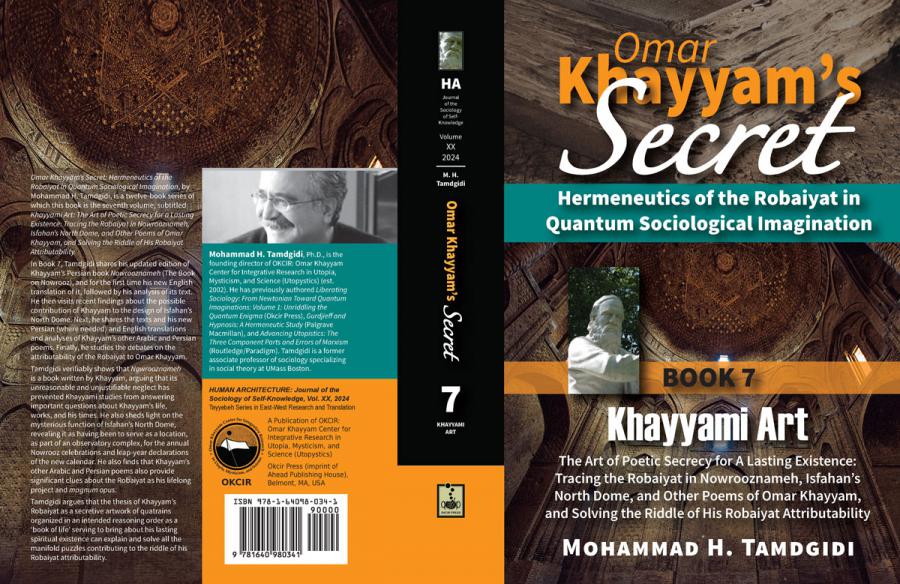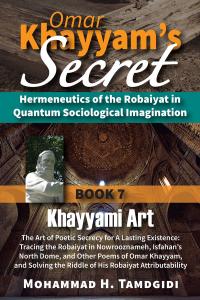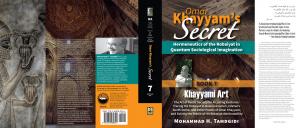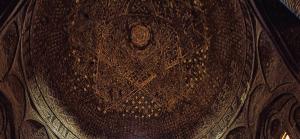
"Khayyami Art": Book 7 of the 12-Book Series "Omar Khayyam's Secret" Released in Continued Celebration of His Millennium
Book 7 traces the Robaiyat in Nowrooznameh, Isfahan's North Dome, and Khayyam's other poems, and explores the riddle of Robaiyat's attributability to Khayyam.
GREATER BOSTON, MASSACHUSETTS, UNITED STATES, March 5, 2024 /EINPresswire.com/ -- "Khayyami Art: The Art of Poetic Secrecy for a Lasting Existence: Tracing the Robaiyat in Nowrooznameh, Isfahan’s North Dome, and Other Poems of Omar Khayyam, and Solving the Riddle of His Robaiyat Attributability"—the 7th book of the 12-Book series "Omar Khayyam’s Secret: Hermeneutics of the Robaiyat in Quantum Sociological Imagination" by Mohammad H. Tamdgidi—was published on March 1, 2024. The series is being published in celebration of the millennium of Khayyam's true birth date AD 1021 (412 LH), and in commemoration of the ninth centennial of his true date of passing in AD 1123 (517 LH) as a 102-year old solar centenarian.
In Book 7, Tamdgidi shares his updated edition of Khayyam’s Persian book "Nowrooznameh" (The Book on Nowrooz), and for the first time his new English translation of it, followed by his analysis of its text. He then visits recent findings about the possible contribution of Khayyam to the design of Isfahan’s North Dome. Next, he shares the texts, and his new Persian (where needed) and English translations and analyses of Khayyam’s other Arabic and Persian poems. Finally he studies the debates about the attributability of the Robaiyat to Omar Khayyam.
Tamdgidi verifiably shows that "Nowrooznameh" is a book written by Khayyam, arguing that its unreasonable and unjustifiable neglect has prevented Khayyami studies from answering important questions about Khayyam’s life, works, and his times. "Nowrooznameh" is primarily a work in literary art, rather than in science, tasked not just with reporting on past truths but with creating new truths in the spirit of Khayyam’s conceptualist view of reality. Iran in fact owes the continuity of its ancient calendar month names to the way Khayyam artfully recast their meanings at that time in order to prevent their being dismissed (given their Zoroastrian roots) during the Islamic solar calendar reform underway under his invited direction.
The book also sheds light on the mysterious function of Isfahan’s North Dome as a space, revealing it as having been to serve, as part of an observatory complex, for the annual Nowrooz celebrations and leap-year declarations of the new calendar. The North Dome, to whose "Khargah" (Grand Tent) design Khayyam verifiably contributed and in fact bears symbols of his unitary view of a world created for happiness by God, marks where the world's most accurate solar calendar of the time was calculated. It deserves to be named after Omar Khayyam (not Taj ol-Molk) and declared as a cultural world heritage site.
"Nowrooznameh" is also a pioneer in the prince-guidance books genre that anticipated the likes of Machiavelli’s "The Prince" by centuries, the difference being that Khayyam’s purpose was to inculcate his Iranian and Islamic love for justice and the pursuit of happiness in the young successors of Soltan Malekshah. Iran is famed for its ways of converting its invaders into its own culture, and "Nowrooznameh" offers a textbook example for how it was artfully done by Khayyam.
Most significantly, however, "Nowrooznameh" offers by way of its intricately multilayered meanings the mediating link between Khayyam’s philosophical, theological, and scientific works, and his Robaiyat, showing through the metaphorical clues of his beautiful prose how his poetry collection could bring lasting spiritual existence to its poet posthumously.
Khayyam’s other Arabic and Persian poems also provide significant clues about the origins, the nature, and the purpose of the Robaiyat as his lifelong project and magnum opus.
Tamdgidi argues that the thesis of Khayyam’s Robaiyat as a secretive artwork of quatrains organized in an intended reasoning order as a ‘book of life’ serving to bring about his lasting spiritual existence can solve the manifold puzzles contributing to the riddle of his Robaiyat attributability. He posits, and in the forthcoming volumes of this series will demonstrate, that the lost quatrains comprising the original collection of Robaiyat have become extant over the centuries, such that we can now reconstruct, by way of solving their 1000-piece jigsaw puzzle, the collection as it was meant to be read as an ode of interrelated quatrains by Omar Khayyam.
——————————————————————
To abstain from everything but this Wine, it’s best.
Served by the Grand-Tent idols, I opine, it’s best.
The best is a rogue free-thinker’s lost wandering.
From the Moon to Earth, trying this Wine’s Shine, it’s best!
— Omar Khayyam (Tamdgidi translation)
——————————————————————
About the Previous Books of the "Omar Khayyam's Secret" Series
The 12-book series “Omar Khayyam's Secret” is being published in celebration of Omar Khayyam’s true birth date millennium and in commemoration of the ninth centennial of the true date of his passing.
In the overall series, Tamdgidi shares the results of his decades-long research on Omar Khayyam, the enigmatic 11th/12th centuries Persian Muslim sage, philosopher, astronomer, mathematician, physician, writer, and poet from Neyshabour, Iran, whose life and works have remained behind a veil of deep mystery. The purpose of his research has been to find definitive answers to the many puzzles still surrounding Khayyam, especially regarding the existence, nature, and purpose of the Robaiyat in his life and works. To explore the questions posed in the series, Tamdgidi advances a new hermeneutic method of textual analysis, informed by what he calls the quantum sociological imagination, to gather and study all the attributed philosophical, religious, scientific, and literary writings of Khayyam.
The first book of the series was subtitled “New Khayyami Studies: Quantumizing the Newtonian Structures of C. Wright Mills’s Sociological Imagination for A New Hermeneutic Method.” In the book, Tamdgidi introduced the quantum sociological imagination method framing his hermeneutic study in the entire series.
The method builds, in an applied way, on the results of Tamdgidi's recent work in the sociology of scientific knowledge, “Liberating Sociology: From Newtonian Toward Quantum Imaginations: Volume 1: Unriddling the Quantum Enigma” (2020). This method is built on the idea that each particle is at once congealed and spread-out; therefore, even if the attribution of Khayyam’s quatrain particles in various manuscripts is in question, his quatrains must also be present in a spread-out way in his verified texts. Hence, his quatrains can best be studied and their attributability determined by way of studying all his other works.
The second book of the series was subtitled “Khayyami Millennium: Reporting the Discovery and the Reconfirmation of the True Dates of Birth and Passing of Omar Khayyam (AD 1021-1123).” In the book, Tamdgidi laid down an essential foundation for the series by revisiting the unresolved questions surrounding the dates of birth and passing of Omar Khayyam.
Critically reexamining the manner in which Khayyam’s birth horoscope as reported in Beyhaqi’s “Tatemmat Sewan al-Hekmat” was used by Swāmi Govinda Tīrtha in his book “The Nectar of Grace: Omar Khayyam’s Life and Works” (1941) to determine Khayyam’s birth date, Tamdgidi uncovered a number of serious internal inconsistencies and factual inaccuracies that prevented Tīrtha (and, since then, other scholars more or less taking for granted his results) from arriving at a reliable date for Khayyam’s birth, hurling Khayyami studies into decades of confusion regarding Khayyam’s life and works. Tamdgidi then shared in the book the detailed account of his own discovery of Khayyam’s true date of birth (AD 1021) for the first time.
He then turned his attention to the task of definitively establishing the true date of passing of Omar Khayyam. Conducting an in-depth, superposed analysis of Beyhaqi’s “Tatemmat Sewan el-Hekmat,” Khazeni’s “Mizan ol-Hekmat,” Nezami Arouzi’s “Chahar Maqaleh,” and Rashidi Tabrizi’s “Tarabkhaneh,” amid other relevant texts, Tamdgidi reconfirmed, in a textually reliable way, the date (AD 1123) on which the poet mathematician, astronomer, and calendar reformer died as a solar centenarian, completing his 102nd solar year age.
The third book of the series was subtitled, “Khayyami Astronomy: How Omar Khayyam’s Newly Discovered True Birth Date Horoscope Reveals the Origins of His Pen Name and Independently Confirms His Authorship of the Robaiyat.” Conducting an in-depth hermeneutic analysis of Khayyam’s horoscope in the book, Tamdgidi further reported having discovered the origins of Khayyam’s pen name in Khayyam’s consideration of his own horoscope.
His analysis of Khayyam’s horoscope in intersection with extant Khayyami Robaiyat also led him to discover an entirely neglected signature quatrain that he proved could not be from anyone but Khayyam, one that provides a reliably independent confirmation of his authorship of the Robaiyat. He also showed how another neglected quatrain reporting its poet to have aged to a hundred is from Khayyam. This meant all the extant Khayyami quatrains are now in need of hermeneutic reevaluation.
Tamdgidi’s further study in Book 3 of a sample of fifty Khayyami Robaiyat led him to conclude that their poet definitively intended the poems to remain in veil, that they were considered to be a collection of interrelated quatrains and not sporadic separate quatrains written marginally in pastime, that they were meant to offer a life’s intellectual journey as in a “book of life,” that the poems’ critically nuanced engagement with astrology was not incidental but essential throughout the collection, and that, judging from the signature quatrain discovered, 1000 quatrains were intended to comprise the collection.
The fourth book of the series was subtitled “Khayyami Philosophy: The Ontological Structures of the Robaiyat in Omar Khayyam’s Last Written Keepsake Treatise on the Science of the Universals of Existence.” In the book, offering the Persian text and his new English translation of the treatise, Tamdgidi explored the ontological structures of the Robaiyat in Khayyam’s last written treatise.
Khayyam’s last keepsake treatise unveils his vision of existence as a participatory universe where the subject has objective status, shedding a new light on the ontological structures of the Robaiyat. His “succession order” thesis of existence is an alternative Islamic creationist-evolutionary worldview that offers a prescient quantum conceptualist vision of the universe as a unitary, relatively self-reliant, self-knowing, and self-creative, substance lovingly created by an absolutely good God in His own image. Existence is essentially good but, due to its also good volitionally self-creative nature, can be potentially subject to incidental defects that are nevertheless knowable and curable to build both a spiritually fulfilling and a joyful life in this world. Other than God’s Necessary Existence there is no “another world”; judgment days, heavens, and hells are definitely real this-worldly, not after-worldly, existents. In Khayyam’s view, human existence can be what good we artfully make of it, starting here-and-now from our own personal selves in our this-worldly lifetimes. It is to creatively realize such an existence that the Robaiyat must have been intended.
The fifth book of the series was titled "Khayyami Theology: The Epistemological Structures of the Robaiyat in All the Philosophical Writings of Omar Khayyam Leading to His Last Keepsake Treatise.” In the book it was shown that the most fruitful way of understanding Khayyam’s six other theological texts is by regarding them as efforts made at defending his “succession order” of creation thesis implicitly revealed when commenting on Avicenna’s sermon and finalized in his last keepsake treatise. The texts served to offer the theological epistemology behind Khayyam’s thesis, revealing his creative conceptualist view of existence that informed his poetic way of going about knowing God, creation, and himself within a unitary Islamic creationist-evolutionary worldview.
Khayyam’s way of knowing God and existence was found to be non-dualistic, non-atomistic, and unitary in worldview, allowing for subject-included objectivity, probabilistic determinism, transcontinuous (or ‘discontinuous’) creative causality, transdisciplinarity, and transculturalism; it thus fulfils in a prescient way all the eight attributes of the quantum vision (Tamdgidi 2020). Poetry is most conducive to unitary knowing, and subject-included objectivity must necessarily be self-reflective and thus engage intellective, emotional, and sensible modes of knowing. This explains why Khayyam transcended scholastic learning in favor of a poetic encounter with reality. What he meant by ‘Drunkenness,’ calling it the highest state of mind known to him, can thus be best understood as a unitary, quantum state of mind achieved by way of his poetry as a meditative art of self-purification (what he called “tazkiyeh-ye nafs”). The goal, metaphorically, is to move from a way of knowing things as divisible grapes to a pure and unitary way of knowing them as indivisible Wine—paralleling what we call today moving from chunky Newtonian toward unitary quantum visions of reality.
Tamdgidi concluded the fifth book by positing that the key for entering Khayyam’s secret tent is realizing that what he primarily meant by ‘Wine’ in his Robaiyat was self-referentially his Robaiyat itself, a key openly hidden therein thanks to his theological epistemology. For him, the Robaiyat was a lifelong work on himself, serving also human spiritual awakening to its place and duty in the succession order of God’s creation. It also served his aspiration for a lasting soul. He knew the now-proven worth of his secret magnum opus, and that is why he so much praised his ‘Wine.’
The sixth book of the series was titled "Khayyami Science: The Methodological Structures of the Robaiyat in All the Scientific Works of Omar Khayyam." Aiming to understand the methodological structures of Omar Khayyam’s Robaiyat as spread out in all of his extant scientific works, Tamdgidi offered the Arabic original texts, their (existing or his new) Persian and his new English translations, followed by hermeneutic analyses of them.
Tamdgidi studied the scientific works in relation to Khayyam’s own theological, philosophical, and astronomical views. The study revealed that Khayyam’s science was informed by a unifying methodological attention to ratios and proportionality. So, likewise, any quatrain he wrote cannot be adequately understood without considering its place in the relational whole of its parent collection. Khayyam’s Robaiyat was found to be, as a critique of fatalistic astrology, his most important scientific work in astronomy rendered in poetic form.
Studying Khayyam’s scientific works in relation to those of other scientists out of the context of his own philosophical, theological, and astronomical views, would be like comparing the roundness of two fruits while ignoring that they are apples and oranges. Khayyam was a relational, holistic, and self-including objective thinker, being systems and causal-chains discerning, creative, transdisciplinary, transcultural, and applied in method. He applied a poetic geometric imagination to solving algebraic problems and his logically methodical thinking did not spare even Euclid of criticism. His treatise on Euclid unified numerical and magnitudinal notions of ratio and proportionality by way of broadening the notion of number to include both rational and irrational numbers, transcending its Greek atomistic tradition.
Khayyam’s conceptualist view of the human subject as an objective creative force in a participatory universe allows for the possibility of human self-determination and freedom depending on his or her self-awakening, a cause for which the Robaiyat was intended. Its collection would be a balanced unity of wisdom gems ascending from multiplicity toward unity using Wine and various astrological, geometrical, numerical, calendrical, and musical tropes in relationally classified quatrains that follow a logical succession order.
About the Author:
Mohammad H. Tamdgidi is the founding director of OKCIR: Omar Khayyam Center for Integrative Research in Utopia, Mysticism, and Science (Utopystics) (www.okcir.com) which has served since 2002 to frame his independent research, teaching, and publishing. He is a former associate professor of sociology specializing in social theory at UMass Boston.
Mohammad Tamdgidi
OKCIR: Omar Khayyam Center for Integrative Research
pressrelease@okcir.com
EIN Presswire does not exercise editorial control over third-party content provided, uploaded, published, or distributed by users of EIN Presswire. We are a distributor, not a publisher, of 3rd party content. Such content may contain the views, opinions, statements, offers, and other material of the respective users, suppliers, participants, or authors.






